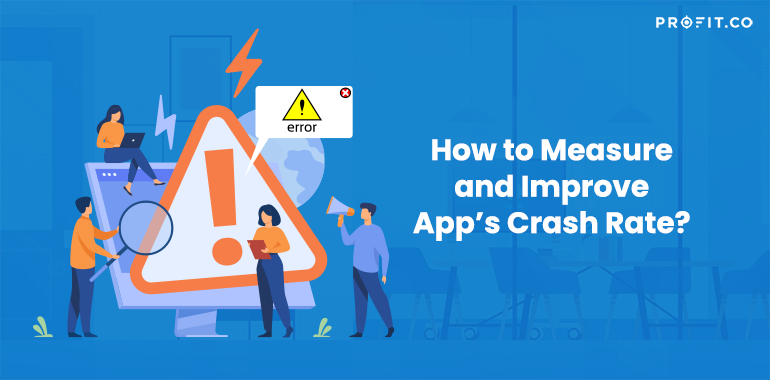In the digital age, where mobile and web applications play a pivotal role in providing services, ensuring these applications function flawlessly is essential. However, this number may vary depending on your app’s type, complexity, and usage. For example, gaming apps tend to have higher crash rates than utility apps and iOS apps tend to have lower crash rates than Android apps. According to one article by Forbes, “Do iOS Apps Crash More Than Android Apps? A Data Dive” The largest proportion of app crashes from both iOS and Android platforms were on iOS 5.01 with 28.64% of overall crashes (in a normalized data set).
One of the ways to measure an app’s stability is by understanding its crash rate. This Key Performance Indicator (KPI) is crucial for developers and product managers alike. Crash rate is one of the most important app KPIs that you should track and optimize. It measures the percentage of app sessions that end in a crash, which is an unexpected app termination due to an error or a bug. A high crash rate indicates poor app performance, user dissatisfaction, and potential revenue loss.
In this blog, we’ll dive deep into the Crash Rate KPI, and its formula, and provide real-world examples to clarify its importance.
What is Crash Rate KPI?
Crash Rate is a metric that indicates the stability of an application. It helps teams understand the percentage of sessions in which the app crashed, providing insight into the app’s overall health and reliability. A high crash rate can negatively impact user experience, lead to poor reviews, and reduce user retention.
A good way to benchmark your app’s crash rate is to compare it with your competitors and industry standards. You can also use tools like Google Play Console or App Store Connect to see how your app ranks in terms of stability and user ratings.
“My job is not to be easy on people. My job is to make them better.”
Have you battled app crashes before?
The Formula for Calculating Crash Rate
The formula for calculating the crash rate for mobile apps is

A session is defined as the period of time that a user spends on your app from launch to exit. A crash is defined as an unexpected termination of the app due to an error or a bug.
Where
- Number of Crashes refers to the total number of times the application crashed during a specific period.
- Number of Sessions refers to the total number of user sessions during the same period.
For example, if your app had 10,000 sessions and 100 crashes in a month, then your monthly crash rate would be:
Crash rate = (100 / 10,000) x 100 = 1%
You can use tools like Firebase Crashlytics or Appsflyer to track and measure your app’s crashes and sessions.
Why is Monitoring Crash Rate Important?
Monitoring crash rate is important because it helps you to evaluate your app’s quality, reliability, and user satisfaction. A high crash rate can have negative impacts on your app’s reputation, retention, and revenue. If your app crashes frequently, you may lose users to your competitors who offer better app performance and stability. Moreover, app crashes can also affect your app’s ratings and reviews, which can influence your app’s discoverability and ranking in the app stores. Therefore, by monitoring and reducing your app’s crash rate, you can improve your app’s performance, user experience, and business outcomes
User retention
High crash rates can deter users from returning to the app, thereby impacting retention rates.
User satisfaction
Frequent crashes can frustrate users, leading to negative reviews and ratings.
Revenue impact
For apps that rely on in-app purchases or ads, crashes can significantly impact revenue.
Best Practices to Follow
Regular monitoring
Ensure you’re consistently tracking crash rates to detect and address any anomalies.
Effective testing
Implement rigorous testing practices to catch potential bugs before they affect users.
User Feedback
Always pay attention to user feedback as it can provide insights into specific issues they might be facing.
Using OKRs to Measure Crash Rate KPI
OKRs are a way to set and track measurable goals for individuals, teams, and organizations. Crash rate is a mobile app KPI that measures the percentage of app sessions that end in a crash. You can use OKRs to measure and improve your app’s crash rate by following these steps.
Objective: Optimize resource allocation towards critical crash points.
KR 1: Reduce response time to critical crashes from 4 hours to 2 hours.
Initiatives: Establish a rapid response team dedicated to addressing high-priority crashes.
KR 2: Increase development resources to address stability issues from 50% to 70%
Initiatives: Reevaluate and adjust the ticketing system to prioritize crash-related issues
KR 3: Resolve 95% of high-priority crash tickets within a week of identification.
Initiatives: Conduct weekly check-ins to assess progress on resolving critical crashes.
Wrapping Up
Crash Rate KPI is a critical metric for gauging the health and performance of an application. Regular monitoring, combined with effective testing and user feedback, can help reduce this rate, ensuring a seamless user experience.

